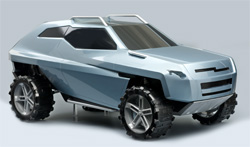
DETROIT – Despite the trend to use exotic materials to make lighter, stronger and more fuel-efficient cars and trucks, several new concepts created by college students are designed to prove steel will continue to be a viable material for vehicle construction.
Unveiled at the College for Creative Studies campus here, the concepts also represent a significant design collaboration between CCS, the University of Michigan and the American Iron and Steel Institute (AISI).
AISI has sponsored CCS vehicle design projects for nearly 20 years, yet 2006 marks the first time engineering disciplines have been incorporated into the curriculum.
By letting designers from CCS collaborate with engineers from U of M, students gain real world experience in collaborative vehicle design, while also showing steel can move with the times and continue to be utilized in future vehicles, says Ron Krupitzer, AISI vice president-Automotive Applications Committee.
“Developing future generations of cars and training the designers behind the concepts means incorporating advanced materials and safety technology into each design,” he says.
For the 2006 AISI summer internship program, three teams were created, each charged with developing a concept vehicle that plays to today’s varying lifestyles and generations of buyers.
The teams, comprised of one CCS design student and one U of M engineering student, developed strikingly different concepts targeted to appeal to either Baby Boomers or buyers from the younger X and Y Generations.
In addition, the U of M students formed a fourth team, tasked with developing a single, flexible platform capable of underpinning all three concepts.
What resulted was a highly flexible architecture utilizing the latest, high-strength steel alloys and capable of forming the foundation of a cross/utility vehicle, sports car and a high-end luxury sports sedan.
Centered around an armrest-high central backbone made of hydroformed steel – similar in design to the current Chevrolet Corvette – and movable, rollover-protecting B-pillars, the chassis could be stretched and altered to accommodate the various entry points and strength requirements for each vehicle.
This element of the project is especially relevant in today’s fast-paced automotive industry, Krupitzer says, referring to the increased use of platform sharing and the push by auto makers for more flexible manufacturing facilities.
With this year’s AISI project, “students gain a breadth of knowledge in new steel applications and incorporate design elements that can be used to meet future needs such as safety, affordability and fuel efficiency,” adds Byron Fitzpatrick, CCS chairman-Transportation Design.
The 2006 AISI/CCS/U of M concepts and their features:

- Land Rover Carver (LRC), by Byung Cho and Sungchul Choi
- A small, rugged CUV inspired by extreme sports, particularly snowboarding, and designed for serious off-road adventuring.
- Aimed at Generation Y (Millennium generation) buyers who are driven, ambitious and heavily involved with technology.
- Strong yet simple character lines, with exposed frame elements and dent-resistant steel body panels.
- Front crossmember-hinged gullwing doors with sliding rear half doors, a la Mazda RX-8, that retreat into the rear quarter panels.

- Volvo Stal, by Carrie Fodor and Aditya Rajderkar
- A low-slung electric sports car for Generation X consumers with rebellious attitudes and no brand loyalty.
- Recyclable, high-strength steel-based construction inspired by Swedish furniture makers, such as Ikea.
- “Tri-pod seating,” consisting of two front seats and a central rear seat capable of accommodating adults.
- Unique C-pillar-less design with reinforced crossmembers and roof bow structure for added protection in case of rollover.

- Cadillac Entourage, by Alex Alequin and Sathish Dhandapani
- A sophisticated and elegant sports sedan design aimed at wealthy, well-educated Baby Boomers who value freedom and adventure.
- Inspired by high-powered luxury yachts and watercraft.
- A-pillar-less design offers panoramic view for occupants, while dual B-pillars improve structural rigidity.
- Four-passenger, back-to-back seating accessed by conventional front doors and rear-hinged rear half doors.
- Retractable “mid-door” between B-pillars allows access to in-vehicle closet.




